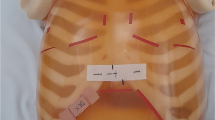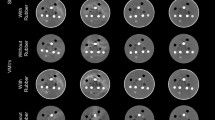Abstract.
The aim of this study was to use a new system of realistic voxel phantoms, based on computed tomography scanning of humans, to assess its ability to specify the internal dosimetry of selected human examples in comparison with the well-established MIRD system of mathematical anthropomorphic phantoms. Differences in specific absorbed fractions between the two systems were inferred by using organ dose estimates as the end point for comparison. A "family" of voxel phantoms, comprising an 8-week-old baby, a 7-year-old child and a 38-year-old adult, was used and a close match to these was made by interpolating between organ doses estimated for pairs of the series of six MIRD phantoms. Using both systems, doses were calculated for up to 22 organs for four radiopharmaceuticals with widely differing biodistribution and emission characteristics (technetium-99m pertechnetate, administered without thyroid blocking; iodine-123 iodide; indium-111 antimyosin; oxygen-15 water). Organ dose estimates under the MIRD system were derived using the software MIRDOSE 3, which incorporates specific absorbed fraction (SAF) values for the MIRD phantom series. The voxel system uses software based on the same dose calculation formula in conjunction with SAF values determined by Monte Carlo analysis at the GSF of the three voxel phantoms. Effective doses were also compared. Substantial differences in organ weights were observed between the two systems, 18% differing by more than a factor of 2. Out of a total of 238 organ dose comparisons, 5% differed by more than a factor of 2 between the systems; these included some doses to walls of the GI tract, a significant result in relation to their high tissue weighting factors. Some of the largest differences in dose were associated with organs of lower significance in terms of radiosensitivity (e.g. thymus). In this small series, voxel organ doses tended to exceed MIRD values, on average, and a 10% difference was significant when all 238 organ doses were considered as a single group. In 12 comparisons of effective dose, the mean voxel to MIRD ratio was 1.07 (range 0.72–1.32). It was shown for the majority of cases that, whereas some large differences in SAF values exist, differences in source organ and effective dose values between the MIRD and voxel methods were largely accounted for by the respective organ mass differences. The reasons for various organ dose differences with the selected radiopharmaceuticals are discussed. Taking biological variation into account, there is reasonable agreement between the two methods but some significant differences exist that warrant further investigation. More extensive comparisons involving a wide variety of voxel phantoms are required to establish whether realistic voxel phantoms should eventually replace the MIRD system.
Similar content being viewed by others
Author information
Authors and Affiliations
Additional information
Received 11 February and in revised form 20 April 2000
Electronic Publication
Rights and permissions
About this article
Cite this article
Smith, T., Petoussi-Henss, N. & Zankl, M. Comparison of internal radiation doses estimated by MIRD and voxel techniques for a "family" of phantoms. Eur J Nucl Med 27, 1387–1398 (2000). https://doi.org/10.1007/s002590000294
Published:
Issue Date:
DOI: https://doi.org/10.1007/s002590000294




